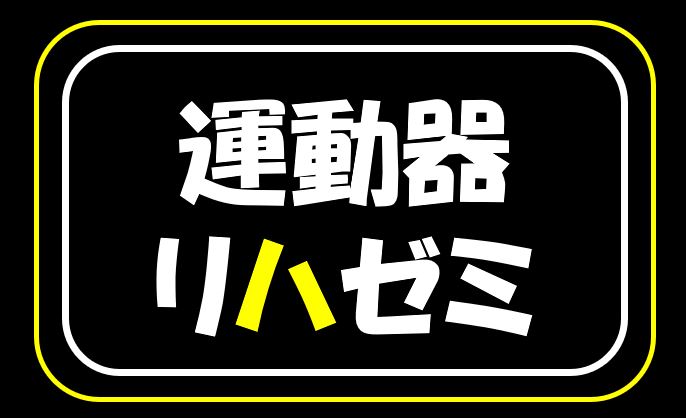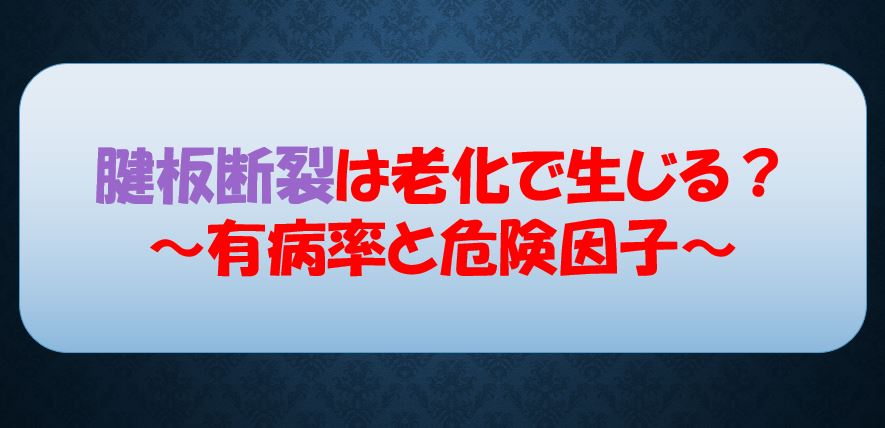こんにちは!
運動器専門のリハビリスタッフです!!
いつもお世話になります。
今回は、『腱板断裂は老化で生じる?~有病率と危険因子~』について解説させていただきます。
●腱板断裂
腱板は棘上筋、棘下筋、小円筋、肩甲下筋の4つの筋で構成されています。
腱板断裂は50~60代で増加していく傾向にあると言われています。
腱板断裂の代表的な症状は上肢の挙上機能不全ですが、痛みに関しては、ある人とない人がいらっしゃいます。
腱板断裂の受傷機転としては主に2つあります。
●外傷による腱板断裂
●退行変性(老化)による腱板断裂
そんな中、2010年に、一般住民における腱板断裂の有病率とリスクファクターを検証した日本人による研究論文が海外で報告されております。
この論文の検証結果が気になるところです。
◆論文紹介
Comparative Study
J Shoulder Elbow Surg (IF: 3.02; Q2)
. 2010 Jan;19(1):116-20.
doi: 10.1016/j.jse.2009.04.006.
Prevalence and risk factors of a rotator cuff tear in the general population
一般住民における腱板断裂の有病率とリスクファクター
Atsushi Yamamoto 1, Kenji Takagishi, Toshihisa Osawa, Takashi Yanagawa, Daisuke Nakajima, Hitoshi Shitara, Tsutomu Kobayashi
Affiliations expand
- PMID: 19540777 DOI: 10.1016/j.jse.2009.04.006
Abstract
Background: Little information is available about the epidemiology of rotator cuff tears in a population-based study. The purpose of this study was to elucidate the true prevalence of rotator cuff tears regardless of the presence or absence of symptoms in the general population and to assess the relationship between tears and their backgrounds.
要旨
背景 腱板断裂の疫学については、母集団を対象とした調査ではほとんど情報が得られていない。本研究の目的は、一般住民における症状の有無にかかわらず腱板断裂の真の有病率を解明し、断裂とその背景の関係を評価することである。
Material and methods: A medical check-up was conducted for residents of a mountain village in Japan. The subjects consisted of 683 people (total of 1,366 shoulders), including 229 males and 454 females with a mean age of 57.9 years (range, 22-87). We examined their background factors, physical examinations and ultrasonographic examinations on both shoulders.
材料と方法 日本のある山村の住民を対象に健康診断を実施した。対象者は、男性229名、女性454名、平均年齢57.9歳(範囲22-87歳)の683名(肩の合計1,366名)である。我々は、彼らの背景因子、身体検査、両肩の超音波検査について検討した。
Results: Rotator cuff tears were present in 20.7% and the prevalence increased with age. Thirty-six percent of the subjects with current symptoms had rotator cuff tears, while 16.9% of the subjects without symptoms also had rotator cuff tears. Rotator cuff tears in the general population were most commonly associated with elderly patients, males, affected the dominant arm, engaged in heavy labor, having a history of trauma, positive for impingement sign, showed lesser active forward elevation and weaker muscle strength in abduction and external rotation. A logistic regression analysis revealed the risk factors for a rotator cuff tear to be a history of trauma, dominant arm and age.
結果は以下の通りである。腱板断裂は20.7%に認められ、有病率は年齢とともに増加した。現在症状のある被験者の36%に腱板断裂があり、症状のない被験者でも16.9%に腱板断裂があった。一般集団における腱板断裂は、高齢者、男性、利き腕に発症、重労働に従事、外傷歴あり、インピンジメント徴候陽性、自動前方挙上が少なく、外転・外旋の筋力低下が最も一般的であった。ロジスティック回帰分析の結果、腱板断裂の危険因子は、外傷の既往、利き腕、年齢であることがわかった。
◆論文の結論
Conclusion: 20.7% of 1,366 shoulders had full-thickness rotator cuff tears in the general population. The risk factors for rotator cuff tear included a history of trauma, dominant arm and age.
結論:一般集団において、1,366肩中20.7%が腱板全面断裂を有していた。腱板断裂の危険因子は、外傷の既往、利き腕、年齢であった。
◆まとめ
日本のある山村の住民683名、1366肩(男性229名、女性454名、平均年齢57.9歳:22-87歳)を対象に健康診断(背景因子、身体検査、両肩の超音波検査)を実施し腱板断裂の状況を調査しております。
その結果、腱板断裂は20.7%に認められ、有病率は年齢とともに増加した。
現在症状のある被験者の36%に腱板断裂があり、症状のない被験者でも16.9%に腱板断裂があった。
一般集団における腱板断裂の特徴としては、高齢者、男性、利き腕に発症、重労働に従事、外傷歴あり、インピンジメント徴候陽性、能動的前方挙上が少なく、外転・外旋の筋力低下がであったそうです。
そして、気になる腱板断裂の危険因子は、外傷の既往、利き腕、年齢であったそうです。
この結果から60歳前後の方では5人に1人が腱板断裂を生じていることがあかりました。
また肩の症状がある方では3人に1人は腱板断裂をしていることもわかりました。
尚且つ、利き手で、男性で、高齢であれば腱板断裂している可能性はさらに高くなりそうです。
今回は、『腱板断裂は老化で生じる?~有病率と危険因子~』について解説させていただきました。



